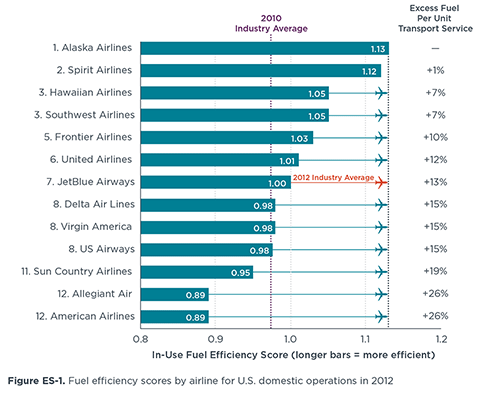Evaluating air carrier fuel efficiency and CO2 emissions in the U.S. airline industry
White paper
U.S. domestic airline fuel efficiency ranking, 2011–2012
Airlines’ in-use fuel efficiency is directly related to aviation’s climate impact. In the U.S., aviation accounted for about 11% of energy-related carbon dioxide emissions from the transportation sector (4% of the U.S. total) in 2010. Globally, aviation GHG emissions are rising 3% to 4% annually, and are on a pace to quadruple by midcentury.
This report updates a 2013 ICCT study that assessed the fuel efficiency of airlines serving the U.S. domestic market in 2010. Overall, the fuel efficiency of those airlines on domestic operations improved by 2.3% from 2010 to 2012, less than what is needed to meet U.S. greenhouse gas (GHG) reduction goals. And the gap between the best and worst performers remained unchanged.
The analysis uses primary airline-reported fuel burn and operations data to compare the fuel efficiency of major U.S. airlines on an apples-to-apples basis regardless of their size, network structure, and type of service, while also evaluating several drivers of in-use efficiency.
Highlights
- In 2011 and 2012 Alaska and Spirit widened their lead over other airlines by adopting advanced technologies and aircraft (Alaska), and efficient operational practices (Spirit). American and Allegiant remained the least fuel-efficient U.S. carriers, largely due to aircraft choice for mainline and affiliate operations. Allegiant has gained ground on American in efficiency terms due to the increasing use of relatively newer, more efficient Boeing 757 aircraft.
- The gap between the best and worst airlines in 2012 remained unchanged from 2010, at 26%. Overall, the fuel efficiency of U.S. domestic operations improved by 2.3% between 2010 and 2012.
- Corporate mergers affected airline efficiency differently. Southwest improved its 2010 efficiency performance substantially, even after its 2012 merger with much less efficient AirTran Airways. In contrast, United’s domestic operations were somewhat less efficient after its merger with the more efficient Continental than would have been predicted from the two airlines’ pre-merger performance.
- Technology has a strong impact on airline efficiency. The most efficient airlines fly newer, more fuel-efficient aircraft.
- Operational practices are also important. Airlines use the same types of aircraft more and less efficiently. Spirit is up to 34% more efficient on a passenger-mile-per-fuel basis with its Airbus aircraft due in part to higher seating densities and passenger load factors. An A320 flight on Spirit may transport 20 to 30 more passengers than one on another carrier. Other factors influencing Spirit’s in-use efficiency may include lighter furnishings and reduced baggage load due to its fee structure.
- Although fuel accounts for about a third of airline operating costs, and fuel prices remained consistently high in the time period studied, there is a poor correlation between efficiency and profitability. The two most efficient carriers, Alaska and Spirit, had the highest net operating profit margins from 2010 to 2012. But the third most profitable airline was Allegiant, followed by Delta Air Lines, both of which pursue a strategy of operating older, cheaper aircraft rather than investing in efficiency.
Attachments
U.S.-Airlines-Ranking-FactSheet2-v3.pdf

